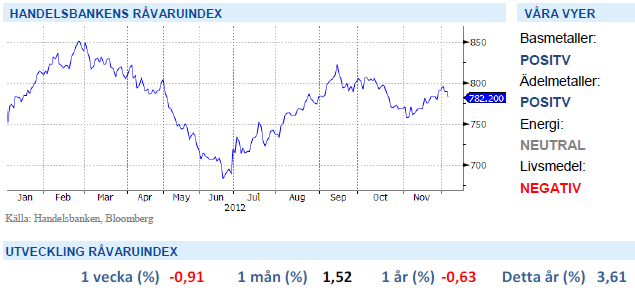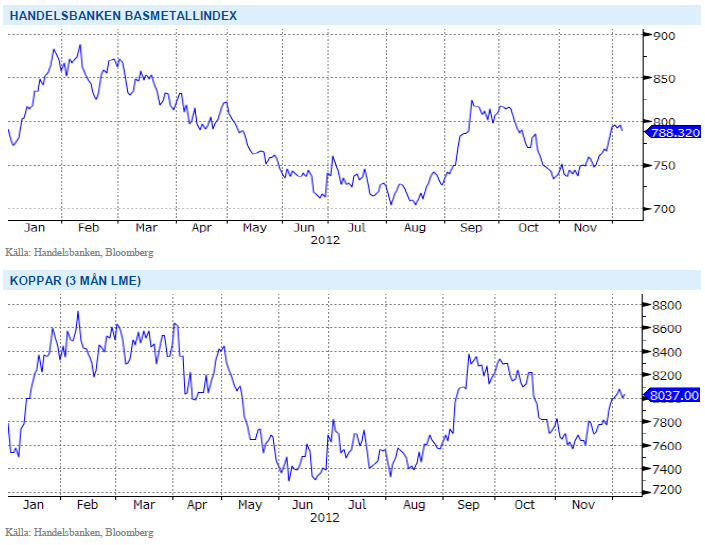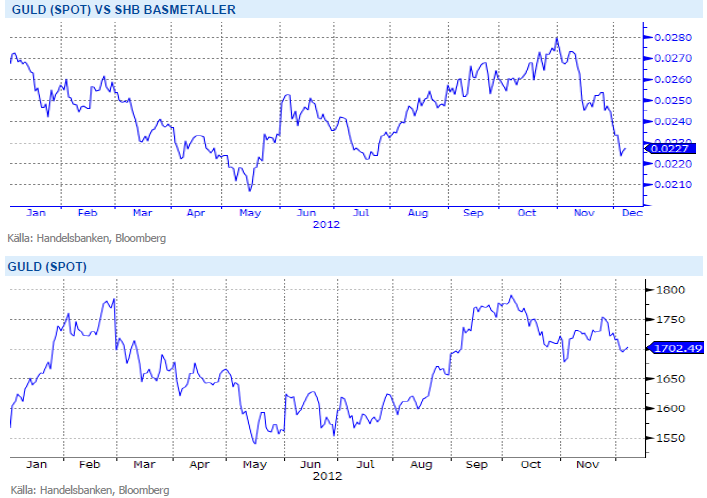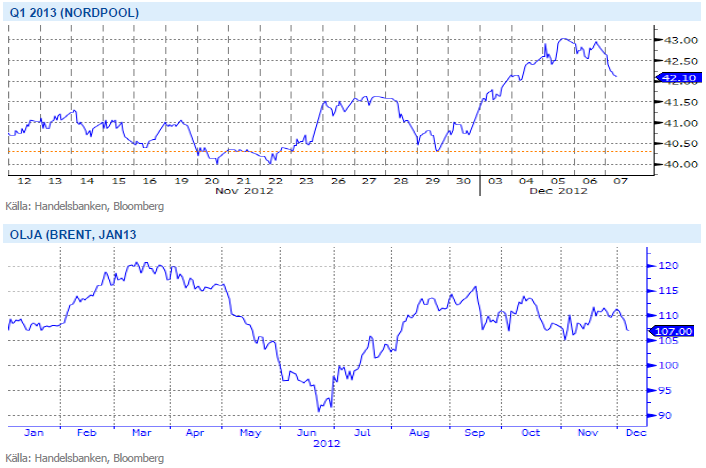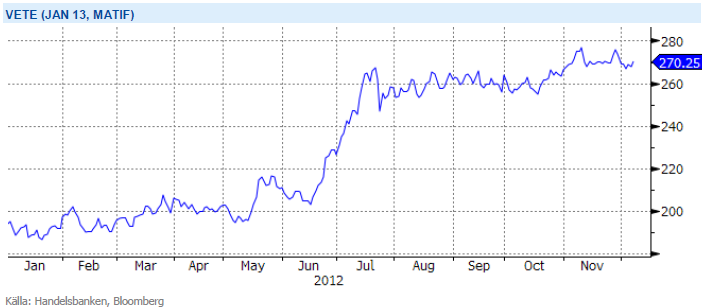Analys
SHB Råvarubrevet 7 december 2012
 Råvaror allmänt
Råvaror allmänt
Global förbättring
Dataskörden sedan förra veckan förstärker bilden om en starkare global konjunktur. Amerikansk inhemsk efterfrågan växer snabbare men industrin hålls tillbaka av finanspolitisk oro (budgetstupet). Konsumentförtroendet ligger på relativt höga nivåer. Faktisk konsumtion var svag i oktober, men av bilförsäljningen att döma accelererar den i november igen. Byggaktiviteten tilltar, drivet av bostadsmarknaden. Inköpschefsindex (ISM) för tillverkningsindustrin var en besvikelse då den återigen landade under 50-strecket. Vi tar inte det så allvarligt utan räknar med ett betydande hopp upp i industriaktivitet i början av 2013, naturligtvis under förutsättning att det finanspolitiska stupet undviks, vilket är vårt huvudscenario.
Novemberdata ger stöd för bottenkänning inom europeisk (läs tysk) industri. Någon snabb återhämtning blir det inte tal om med tanke på bred finanspolitisk åtstramning och fortsatt djup recession i Sydeuropa. Med tanke på de lågt ställda förväntningarna ser vi dock begränsade risker på nedsidan. ECB fortsätter också att begränsa finansiell oro.
Snabbare uppåt går det däremot i Kina. Sedan återhämtningen tog fart på allvar under hösten har de kinaberoende basmetallerna stigit kraftigt. Vi var tidigare oroliga för att den svaga kinesiska börsen skulle få uppgången på fall men denna vecka har kinabörsen tagit ett rejält kliv uppåt och ger stöd för fortsatt uppgång bland basmetallerna.
Den råvara som sticker ut på nedsidan är olja där vi fortfarande har en riskpremie i brentpriset. En vecka utan eskalerande tumult i Mellanöstern får priset på fall.
Basmetaller
Kina stärker basmetallerna
Stark data från Kina och en svag dollar har drivit basmetallerna egentligen under hela november. Senaste veckan har dock uppgången bytts till nedgång men handelsbankens basmetallindex stänger ändå upp 0,79 % på en vecka. Under veckan har koppar återigen handlats upp över 8000 nivån, senast på denna nivå var i mitten av oktober. Rykten om nya QE samtal på Fed´s FOMC möte nästa vecka kan komma att driva basmetaller ytterligare, tidigare har det visat sig att basmetaller är väldigt känsliga för vad Fed säger och gör.
Basmetallerna stärktes ytterligare på fredag eftermiddag efter positiv arbetsmarknads statisk från USA. Nonfarm payroll för november, som anger antal nya jobb utanför jordbrukssektorn, kom in på 146 000 mot väntade 85 000.
Under oktober hade basmetallerna ett kraftigt ras, efter den kraftiga uppgången i september. Finansmarknaden hade handlat in för mycket på för kort tid. Däremot ser Kinadata allt bättre ut nu. Vi tror på: BASMET H
Ädelmetaller
Vi tror fortsatt på guldet
Guldet har fallit med ungefär en procent sedan förra veckans brev, en vecka som präglats av stigande börser men fallande basmetallpriser. Vårt huvudscenario är alltjämt att de exceptionellt låga räntorna globalt och tilltagande inflationsoro kommer att pressa guldpriset uppåt. Vi ser detta som viktigare drivkraft för guldpriset än det mer vanliga skälet att man skyddar sig mot riskaversion.
Vi har tidigare under året lyft fram det faktum att hela ädelmetallsektorn varit väldigt väl korrelerad med basmetallsektorn, en utveckling som inte har varit jättevanlig i ett historiskt perspektiv. De senaste fem åren har dessa sektorer uppvisat väldigt olika prisutveckling, fram till september förra året då guldet också toppade ut i absoluta tal. Därefter har de rört sig i samklang med varann, med väldigt små skillnader.
Under november månad har basmetallerna – drivna av Kinas återhämtning – stigit kraftigt jämfört med guldet, och frågan är nu om den resan är klar nu (se graf nedan, guld mot Handelsbankens basmetallindex). Vi är fortsatt positiva till basmetaller, och om vi återgår till mönstret vi sett sedan september förra året kommer även basmetallerna att agera draglok åt guldet.
Vi är fortsatt positiva till ädelmetaller med den främsta anledningen att vi tror på fortsatt mjuk penningpolitik från FED och att central bankernas stimulanser forstätter att ge stöd. Vi tror på: ADELMET H
Energi
Kärnkraften sviker, trots tidigare löfte
I höstas utlovades det att Sveriges kärnkraftverk skulle gå på full installerad effekt under vintern och därmed minska risken för höga elpriser. I samband med kyla kommer nu även rapporter om stopp i kärnkraftverken och spotpriset. Ringhals 1 är åter i drift efter turbinunderhåll men i Oskarshamn står två av tre reaktorer stilla. Oskarshamn 1 är nere på grund av turbinarbeten, väntas åter i drift i slutet av vecka 50 och Oskarshamn 2 stoppades igår efter krav från Strålsäkerhetsmyndighen att se underhållssituationen på två av sina dieselreservkraftverk, osäkert när reaktorn kan tas i drift igen. Trots gårdagens incident vid oskarshamnsverken har både termins- och spotpriset fallit till idag. Kvartalskontraktet, Q1 2013 (som är underliggande till SHB POWER), har stigit med 2 % under veckan, men faller under senare delen då väderprognoser talar för mildare temperaturer. Med fortsatt energiöverskott behåller vi en neutral syn för elpriset. Från och med måndag är underliggande till SHB POWER kvartalskontraktet Q2 2013, även kallat vårflodskontraktet.
Priset på olja har fallit under veckan, Brent-oljan handlas nu 4,2 % lägre än veckans öppning. Riskpremie för upptrappad konflikt i mellanösterns finns fortfarande men har pyst ut något under veckan. Även dystra utsikter för euroområdets tillväxt grusar oljans prisutveckling. ECB, som i september trodde på en BNP tillväxt på -0,4% har nu reviderat ned till -0,5% för 2012. Oro över en fördjupad kris för euroområdet dämpar förväntningar på ökad efterfrågan för drivmedel.
Oljan har sett allt svagare ut och vi fortsätter tycka att underliggande fundamenta är väl balanserad. Vi ser även att förutsättningarna för fortsatt lågt elpris kvarstår. Vi håller en neutral syn på energisektorn.
Livsmedel
Fortsatt problem för vetet
Terminspriser på vete är i stort sett oförändrade sedan förra veckan i både Chicago och Paris. I USA har höstvetet bara fått mycket små regnmängder under veckan, dessutom är temperaturerna högre än normalt för den här tiden på året så grödornas skick riskerar att försämras ytterligare innan vintervilan. I Australien har det generellt sett varit torrt så skörden har fortsatt utan större problem, varierande kvalitet uppges vad gäller proteinhalt – dock inga stora problem. I Argentina har det fallit mer regn, vilket inte alls är bra för pågående skörd och kvalitetsnivå – torrare väder väntas dock igen nästa vecka.
I EU har det blivit kallare och grödorna kommer allt närmare vintervilan. I Ukraina har det varit varmare än normalt, ofta med plusgrader så vintervilan får dröja ett tag till ser det ut som. De torra delarna av södra Ryssland har fått en del regn och grödorna bedöms vara i tillfredställande skick.
Med inte alls obetydliga problem för de höstsådda grödorna, och även för pågående skörd på södra halvklotet, bör en eventuell nedsida vara väldigt begränsad på kort sikt. En bra start på grödan är givetvis att föredra men mycket kan hända tills nästa års skörd, helt klart är oron stor för det amerikanska vetet men vi har sett förr att de höstsådda grödorna återhämtat sig väl efter vintern.
Vi ser soja, majs och vete som klara säljcase där vi väntar oss prisfall senast till påsk. Vi tror på: LIVSMEDEL S H
Handelsbankens Råvaruindex

Handelsbankens råvaruindex består av de underliggande indexen för respektive råvara. Vikterna är bestämda till hälften från värdet av global produktion och till hälften från likviditeten i terminskontrakten.
[box]SHB Råvarubrevet är producerat av Handelsbanken och publiceras i samarbete och med tillstånd på Råvarumarknaden.se[/box]
Ansvarsbegränsning
Detta material är producerat av Svenska Handelsbanken AB (publ) i fortsättningen kallad Handelsbanken. De som arbetar med innehållet är inte analytiker och materialet är inte oberoende investeringsanalys. Innehållet är uteslutande avsett för kunder i Sverige. Syftet är att ge en allmän information till Handelsbankens kunder och utgör inte ett personligt investeringsråd eller en personlig rekommendation. Informationen ska inte ensamt utgöra underlag för investeringsbeslut. Kunder bör inhämta råd från sina rådgivare och basera sina investeringsbeslut utifrån egen erfarenhet.
Informationen i materialet kan ändras och också avvika från de åsikter som uttrycks i oberoende investeringsanalyser från Handelsbanken. Informationen grundar sig på allmänt tillgänglig information och är hämtad från källor som bedöms som tillförlitliga, men riktigheten kan inte garanteras och informationen kan vara ofullständig eller nedkortad. Ingen del av förslaget får reproduceras eller distribueras till någon annan person utan att Handelsbanken dessförinnan lämnat sitt skriftliga medgivande. Handelsbanken ansvarar inte för att materialet används på ett sätt som strider mot förbudet mot vidarebefordran eller offentliggörs i strid med bankens regler.
Analys
Brent crude ticks higher on tension, but market structure stays soft

Brent crude has climbed roughly USD 1.5-2 per barrel since Friday, yet falling USD 0.3 per barrel this mornig and currently trading near USD 67.25/bbl after yesterday’s climb. While the rally reflects short-term geopolitical tension, price action has been choppy, and crude remains locked in a broader range – caught between supply-side pressure and spot resilience.

Prices have been supported by renewed Ukrainian drone strikes targeting Russian infrastructure. Over the weekend, falling debris triggered a fire at the 20mtpa Kirishi refinery, following last week’s attack on the key Primorsk terminal.
Argus estimates that these attacks have halted ish 300 kbl/d of Russian refining capacity in August and September. While the market impact is limited for now, the action signals Kyiv’s growing willingness to disrupt oil flows – supporting a soft geopolitical floor under prices.
The political environment is shifting: the EU is reportedly considering sanctions on Indian and Chinese firms facilitating Russian crude flows, while the U.S. has so far held back – despite Bessent warning that any action from Washington depends on broader European participation. Senator Graham has also publicly criticized NATO members like Slovakia and Hungary for continuing Russian oil imports.
It’s worth noting that China and India remain the two largest buyers of Russian barrels since the invasion of Ukraine. While New Delhi has been hit with 50% secondary tariffs, Beijing has been spared so far.
Still, the broader supply/demand balance leans bearish. Futures markets reflect this: Brent’s prompt spread (gauge of near-term tightness) has narrowed to the current USD 0.42/bl, down from USD 0.96/bl two months ago, pointing to weakening backwardation.
This aligns with expectations for a record surplus in 2026, largely driven by the faster-than-anticipated return of OPEC+ barrels to market. OPEC+ is gathering in Vienna this week to begin revising member production capacity estimates – setting the stage for new output baselines from 2027. The group aims to agree on how to define “maximum sustainable capacity,” with a proposal expected by year-end.
While the IEA pegs OPEC+ capacity at 47.9 million barrels per day, actual output in August was only 42.4 million barrels per day. Disagreements over data and quota fairness (especially from Iraq and Nigeria) have already delayed this process. Angola even quit the group last year after being assigned a lower target than expected. It also remains unclear whether Russia and Iraq can regain earlier output levels due to infrastructure constraints.
Also, macro remains another key driver this week. A 25bp Fed rate cut is widely expected tomorrow (Wednesday), and commodities in general could benefit a potential cut.
Summing up: Brent crude continues to drift sideways, finding near-term support from geopolitics and refining strength. But with surplus building and market structure softening, the upside may remain capped.
Analys
Volatile but going nowhere. Brent crude circles USD 66 as market weighs surplus vs risk

Brent crude is essentially flat on the week, but after a volatile ride. Prices started Monday near USD 65.5/bl, climbed steadily to a mid-week high of USD 67.8/bl on Wednesday evening, before falling sharply – losing about USD 2/bl during Thursday’s session.

Brent is currently trading around USD 65.8/bl, right back where it began. The volatility reflects the market’s ongoing struggle to balance growing surplus risks against persistent geopolitical uncertainty and resilient refined product margins. Thursday’s slide snapped a three-day rally and came largely in response to a string of bearish signals, most notably from the IEA’s updated short-term outlook.
The IEA now projects record global oversupply in 2026, reinforcing concerns flagged earlier by the U.S. EIA, which already sees inventories building this quarter. The forecast comes just days after OPEC+ confirmed it will continue returning idle barrels to the market in October – albeit at a slower pace of +137,000 bl/d. While modest, the move underscores a steady push to reclaim market share and adds to supply-side pressure into year-end.
Thursday’s price drop also followed geopolitical incidences: Israeli airstrikes reportedly targeted Hamas leadership in Doha, while Russian drones crossed into Polish airspace – events that initially sent crude higher as traders covered short positions.
Yet, sentiment remains broadly cautious. Strong refining margins and low inventories at key pricing hubs like Europe continue to support the downside. Chinese stockpiling of discounted Russian barrels and tightness in refined product markets – especially diesel – are also lending support.
On the demand side, the IEA revised up its 2025 global demand growth forecast by 60,000 bl/d to 740,000 bl/d YoY, while leaving 2026 unchanged at 698,000 bl/d. Interestingly, the agency also signaled that its next long-term report could show global oil demand rising through 2050.
Meanwhile, OPEC offered a contrasting view in its latest Monthly Oil Market Report, maintaining expectations for a supply deficit both this year and next, even as its members raise output. The group kept its demand growth estimates for 2025 and 2026 unchanged at 1.29 million bl/d and 1.38 million bl/d, respectively.
We continue to watch whether the bearish supply outlook will outweigh geopolitical risk, and if Brent can continue to find support above USD 65/bl – a level increasingly seen as a soft floor for OPEC+ policy.
Analys
Waiting for the surplus while we worry about Israel and Qatar

Brent crude makes some gains as Israel’s attack on Hamas in Qatar rattles markets. Brent crude spiked to a high of USD 67.38/b yesterday as Israel made a strike on Hamas in Qatar. But it wasn’t able to hold on to that level and only closed up 0.6% in the end at USD 66.39/b. This morning it is starting on the up with a gain of 0.9% at USD 67/b. Still rattled by Israel’s attack on Hamas in Qatar yesterday. Brent is getting some help on the margin this morning with Asian equities higher and copper gaining half a percent. But the dark cloud of surplus ahead is nonetheless hanging over the market with Brent trading two dollar lower than last Tuesday.

Geopolitical risk premiums in oil rarely lasts long unless actual supply disruption kicks in. While Israel’s attack on Hamas in Qatar is shocking, the geopolitical risk lifting crude oil yesterday and this morning is unlikely to last very long as such geopolitical risk premiums usually do not last long unless real disruption kicks in.
US API data yesterday indicated a US crude and product stock build last week of 3.1 mb. The US API last evening released partial US oil inventory data indicating that US crude stocks rose 1.3 mb and middle distillates rose 1.5 mb while gasoline rose 0.3 mb. In total a bit more than 3 mb increase. US crude and product stocks usually rise around 1 mb per week this time of year. So US commercial crude and product stock rose 2 mb over the past week adjusted for the seasonal norm. Official and complete data are due today at 16:30.
A 2 mb/week seasonally adj. US stock build implies a 1 – 1.4 mb/d global surplus if it is persistent. Assume that if the global oil market is running a surplus then some 20% to 30% of that surplus ends up in US commercial inventories. A 2 mb seasonally adjusted inventory build equals 286 kb/d. Divide by 0.2 to 0.3 and we get an implied global surplus of 950 kb/d to 1430 kb/d. A 2 mb/week seasonally adjusted build in US oil inventories is close to noise unless it is a persistent pattern every week.
US IEA STEO oil report: Robust surplus ahead and Brent averaging USD 51/b in 2026. The US EIA yesterday released its monthly STEO oil report. It projected a large and persistent surplus ahead. It estimates a global surplus of 2.2 m/d from September to December this year. A 2.4 mb/d surplus in Q1-26 and an average surplus for 2026 of 1.6 mb/d resulting in an average Brent crude oil price of USD 51/b next year. And that includes an assumption where OPEC crude oil production only averages 27.8 mb/d in 2026 versus 27.0 mb/d in 2024 and 28.6 mb/d in August.
Brent will feel the bear-pressure once US/OECD stocks starts visible build. In the meanwhile the oil market sits waiting for this projected surplus to materialize in US and OECD inventories. Once they visibly starts to build on a consistent basis, then Brent crude will likely quickly lose altitude. And unless some unforeseen supply disruption kicks in, it is bound to happen.
US IEA STEO September report. In total not much different than it was in January
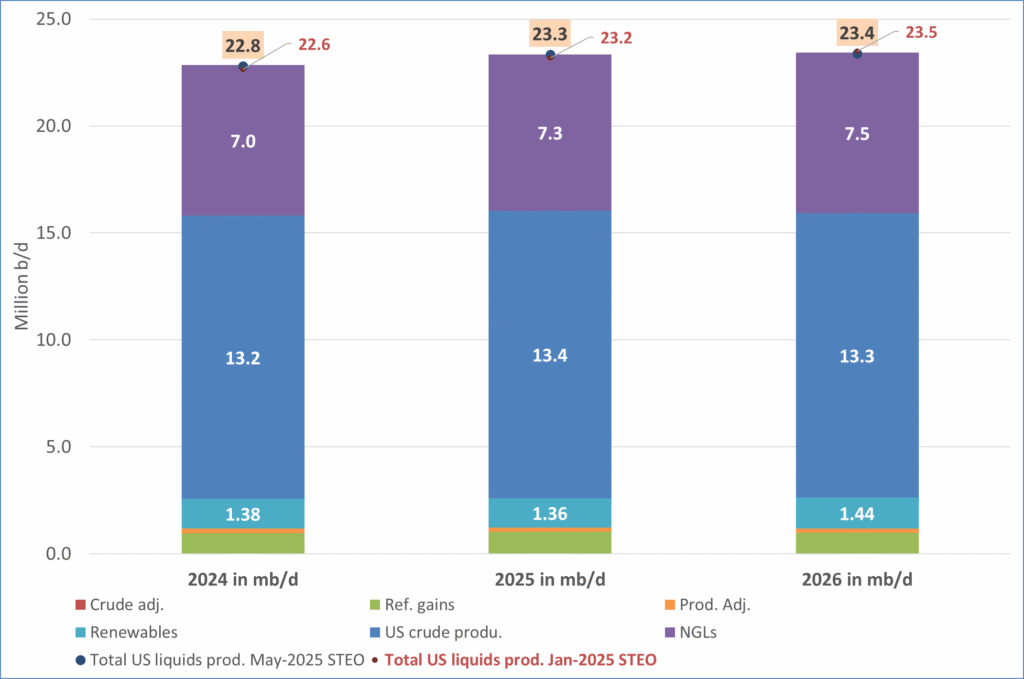
US IEA STEO September report. US crude oil production contracting in 2026, but NGLs still growing. Close to zero net liquids growth in total.
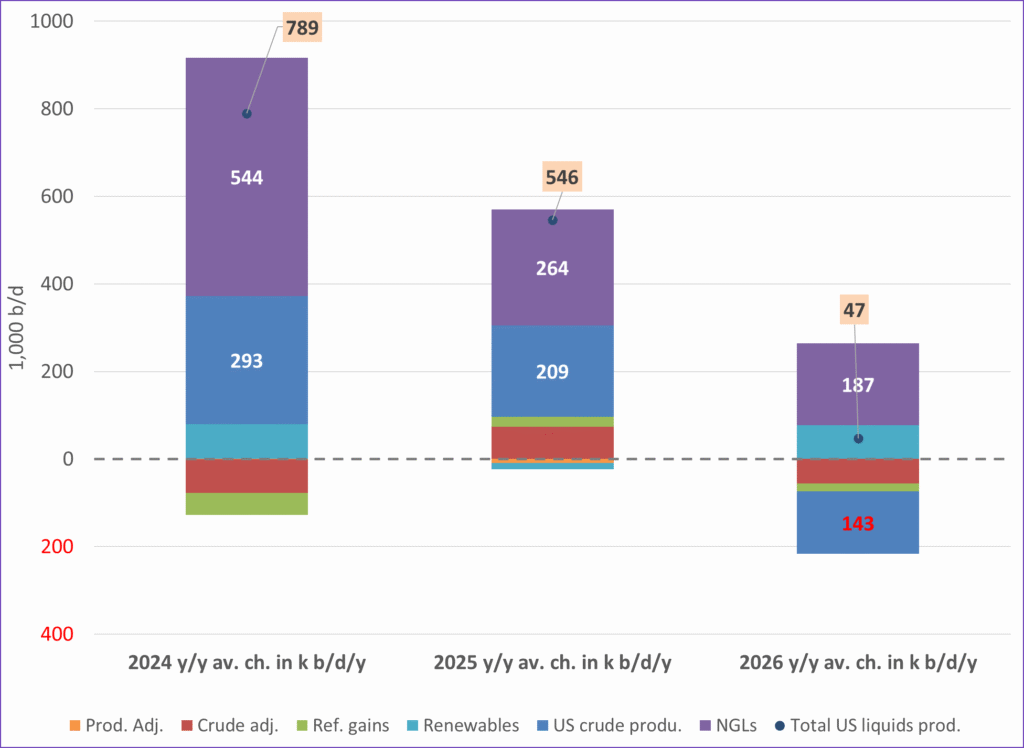
-

 Nyheter4 veckor sedan
Nyheter4 veckor sedanMeta bygger ett AI-datacenter på 5 GW och 2,25 GW gaskraftverk
-
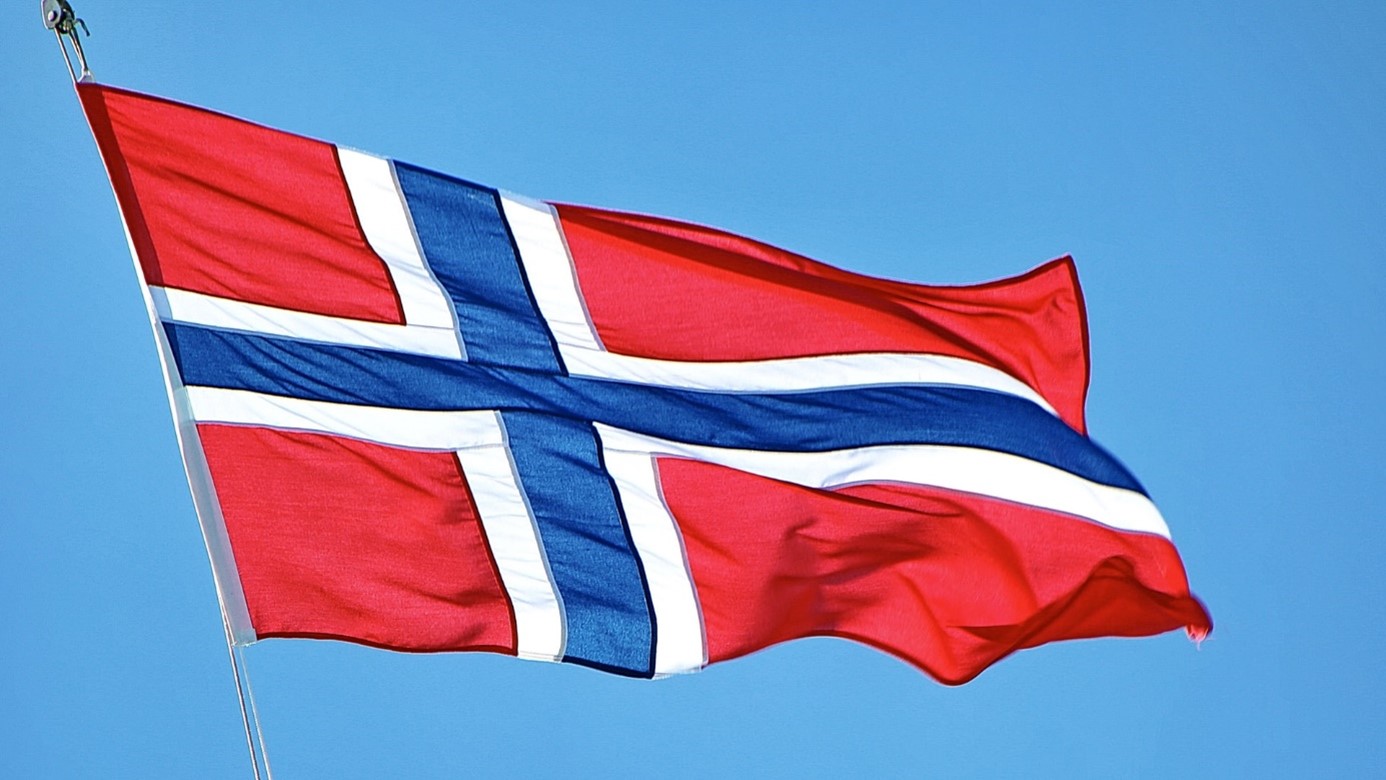
 Nyheter4 veckor sedan
Nyheter4 veckor sedanAker BP gör ett av Norges största oljefynd på ett decennium, stärker resurserna i Yggdrasilområdet
-

 Nyheter4 veckor sedan
Nyheter4 veckor sedanSommarens torka kan ge högre elpriser i höst
-

 Analys4 veckor sedan
Analys4 veckor sedanBrent edges higher as India–Russia oil trade draws U.S. ire and Powell takes the stage at Jackson Hole
-
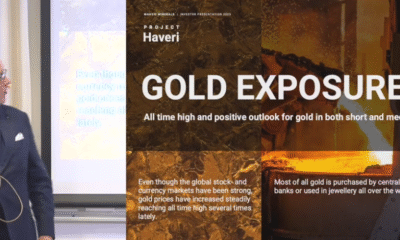
 Nyheter3 veckor sedan
Nyheter3 veckor sedanMahvie Minerals är verksamt i guldrikt område i Finland
-

 Analys3 veckor sedan
Analys3 veckor sedanIncreasing risk that OPEC+ will unwind the last 1.65 mb/d of cuts when they meet on 7 September
-

 Analys2 veckor sedan
Analys2 veckor sedanOPEC+ in a process of retaking market share
-

 Nyheter3 veckor sedan
Nyheter3 veckor sedanNeil Atkinson spår att priset på olja kommer att stiga till 70 USD


